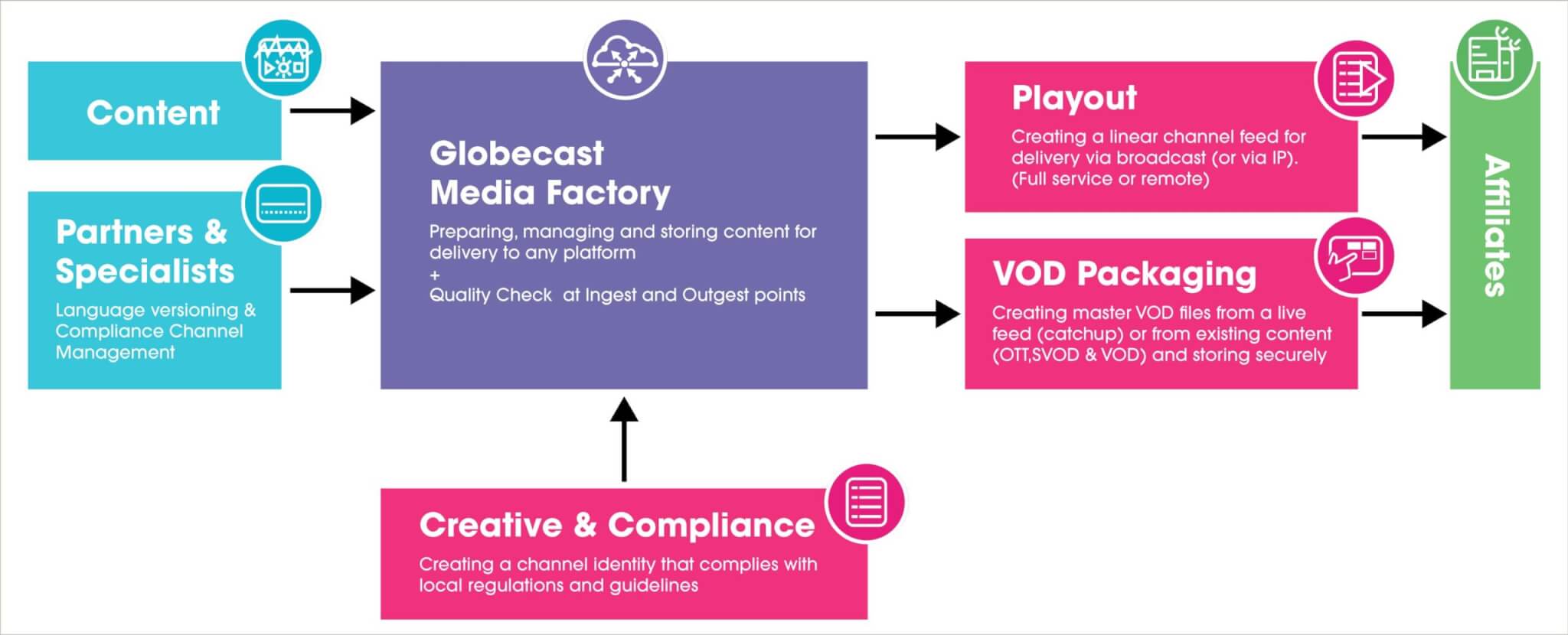by Sally Jones, Playout Manager, Globecast in the UK
Sally Jones is Playout Manager at Globecast in the UK. She’s been working in the field for quite some time and she’s pulled together her thoughts on how to create a TV channel. With insights from Ang Sookhoon, Director Channel Ops at Globecast in Asia.
Read Part 1: The Dream
Media Asset Management

A MAM system will allow you to catalogue the metadata for all of your assets. Sure, a DIY solution is a spreadsheet but that has its strict limits. When your core business is based on monetising content, rights management is always going to be a challenge. There are rights holder details, multiple contract periods and play counts to track and provide reporting on. With a large catalogue of content, you’re not going to want to track that manually or give yourself a data overload crisis. MAM systems make it easier for the user to find and retrieve content, view, mark-up and generally organise, allowing you to store assets at series, episode and version levels should that be required.
Schedule Management and EPG

The most underestimated part of the operational architecture is the schedule management and traffic system platform, which is really the backbone of the successful launch of a TV channel. Without the ability to actually schedule all of your content, the channel isn’t going to come to fruition. This is key to its success. A schedule management platform, once integrated with the export type of your chosen playout provider, is your tool to bring the channel and brand to life.
A good schedule management tool should contain features such as long-term planner modules, linear and/or non-linear transmission scheduling, media library, promo campaign, licence and rights, version, EPG and ad sales management modules.
Filling a full 24 hours might sound like a fairly simple task but I highly recommend the recruit of an experienced on-air planner. If your start-up library only consists of a significantly small number of titles, it becomes somewhat of a challenge to switch these up over a 24-hour period. A small 24-hour schedule consists of around 30-50 assets while a heavy commercial laden channel in the region of 200-250 assets a day.
Globecast works in partnership with third parties experienced in building broadcast schedules and providing EPG information to the platforms.
Planning Schedule

In a world where audiences can self-serve their own schedule via on-demand options, it becomes a key question for schedulers as to how they will best meet the challenge of establishing that they are proficient storytellers and earn the loyalty of their audience.
The planning schedule is the place where that begins, taking the form of a high-level weekly blocked out grid. It gets fleshed out in later stages of the scheduling process, but this essential stage is where it’s decided what to play and when.
Yet you don’t want to just throw titles down onto a spreadsheet! The planning schedule is where you start to craft that connection you want to make with your viewers. There is an art to scheduling that requires passion at its core. You need to be able to harness audience data and use that to drive the composition of the daily schedule, selecting the titles with the right pulling power and range of choice into each programming slot: breakfast, mid-morning, post-midday, etc.
While your planning schedule requires structure and forethought, you also want to ensure that there’s room to exercise flexibility so that adjustments to fit with breaking news and trends in worldwide cultural and current affairs can be made. This is the time to become that master story-teller.
In my experience, the large broadcasters I have worked with start to lock in their planning schedules at around TX -10 weeks. If by TX -8 weeks you are then in a position to have that planning schedule transposed into your scheduling system, it puts you in a good position on the timeline for content prep, delivery and supply of advanced schedule information to both your playout provider and for EPG (electronic programme guide) listings.
By the time you come to fleshing out the final presentation schedule with brand-tailored promotional junctions, it will be with the objective of how it even further develops your audience’s experience.
Short-form and Advertising
This is the second largest, most underestimated consideration with regards to the construction of a TV channel schedule. You come to flesh out that final presentation schedule; you’ve made a small handful of channel promotions and then you realise that programmes don’t come in lovely round minutes like you had plumbed into the planning schedule. There are odd seconds and straggler frames and no matter how many various ways you plug in the small handful of thirty-second promotions, the whole schedule just doesn’t time out, which would leave you with a black screen on air.
Having a range of short-form content here is the answer to success. Short-form is an all-encompassing term for bumpers, menus, promotions, idents etc. Don’t underestimate how many you will need to avoid close repetition. Consider what your break structure should look like. The breaks are your chance to reconnect with your audience and remind them of the channel and its values. Break structures at the top of the programme are often differently identified to mid-programme breaks.
Is there an intention to show commercial advertising? Will you be engaging with a commercial advertising sales house? This opens up new revenue stream possibilities but you need to know that it also increases the complexity of scheduling and content delivery.
Commercial scheduling is structured in its distribution through a schedule and often bound to a maximum number of minutes per hour. Reconciliation of what’s been played out, by means of an As-Run, is an essential part of the agreement to getting paid. Commercial scheduling is done by means of an advanced break pattern export from the scheduling system, derived from that all-important locked planning schedule, usually at around TX -4 weeks. The advertising sales house fills the break pattern either fully or in part and returns that by means of a spot file. When imported into your scheduling system, it will begin to fill up the break junctions. You can hopefully see how a timeline from planning to presentation schedule begins to firm up and your final schedule starts to take shape.
To be continued.

